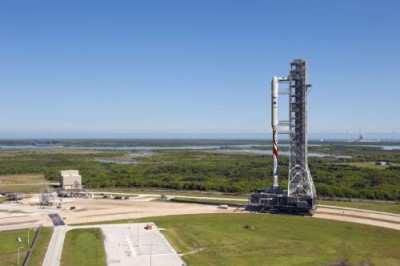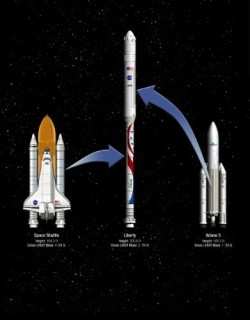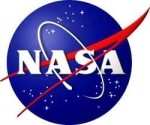Designed for NASA's CCDev-2 Competition, Companies Say Liberty
Can Achieve, First Flight by 2013
ATK and Astrium are working together in response to NASA's
Commercial Crew Development-2 (CCDev-2) procurement, offering NASA
launch services with the Liberty rocket. This new launch vehicle
combines two of the world's most reliable propulsion systems, with
a collective heritage of nearly 150 successful flights. The
companies say the new vehicle has the potential to greatly reduce
the expected "Human Space Flight Gap" for the U.S.

Photo Courtesy ATK
ATK would supply the human-rated first stage, which it developed
under NASA's Space Exploration Program. The five-segment solid
rocket first stage is derived from the Space Shuttle's four-segment
solid rocket boosters (SRBs) which are built by ATK and have flown
107 successful missions since 1988 (encompassing 214 SRBs).
Astrium, the developer and manufacturer of the Ariane 5
launcher, working with Snecma (Safran Group), Europe's leading
propulsion company, is providing Liberty's second stage based on
the liquid-fueled cryogenic core of the Ariane 5 vehicle powered by
the Vulcain2 engine. The Ariane 5 Launcher, operated by
Arianespace, has flown more than 40 consecutive successful missions
over nearly eight years and has launched more commercial satellites
than any other launch vehicle in the world during that time. The
Ariane 5 enjoys the lowest launch insurance rates in the industry
due to an unrivaled safety record in the commercial launch services
market.
"This team represents the true sense of international
partnership in that we looked across borders to find the best for
our customers," said Blake Larson, President of ATK Aerospace
Systems Group. "Together we combine unique flight-proven systems
and commercial experience that allows us to offer the market's most
capable launch vehicle along with flexibility to meet a wide
variety of emerging needs. Liberty provides greater performance at
less cost than any other comparable launch vehicle."

Image Courtesy ATK
Liberty would be a two stage launcher able to deliver 44,500
pounds to the International Space Station orbit, which would give
it a launch capability to carry any crew vehicle in development.
Both stages were designed for human-rating since inception and
would enable unmatched crew safety. Since Liberty uses qualified,
proven, and reliable systems, the team has planned an initial
flight by the end of 2013, a second test flight in 2014, and
operational capability in 2015.
"The Liberty initiative provides tremendous value because it
builds on European Ariane 5 launcher heritage, while allowing NASA
to leverage the mature first stage," said Charlie Precourt, Vice
President and General Manager of ATK Space Launch Systems. "We will
provide unmatched payload performance at a fraction of the cost,
and we will launch it from the Kennedy Space Center using
facilities that have already been built. This approach allows NASA
to utilize the investments that have already been made in our
nation's ground infrastructure and propulsion systems for the Space
Exploration Program."
The advantages of the Liberty launch system are extensive. It is
built on a solid foundation of human-rated launch technology, and
leverages billions of dollars of investments by NASA and
NATO-allied European Governments in the frame of the European Space
Agency. This international effort—which embodies the spirit
of global cooperation articulated in the recent National Space
Policy—will afford NASA a readily available, cost-effective
solution for human spaceflight. Finally, NASA is already extremely
familiar with the Ariane and ATK launch systems, both of which have
played historic roles in directly supporting NASA's mission.

The five-segment first stage design is based on more than 30
years of safety-driven improvements on the space shuttle program.
The result is a higher performing, more reliable solid rocket
motor, which equates to increased safety for crew and mission
success for cargo. Besides adding a fifth segment, ATK also
enhanced the propellant grain, provided a larger nozzle opening,
and upgraded the liner and insulation — all designed to meet
performance requirements and increase reliability while
significantly lowering manufacturing costs.
The five-segment first stage was successfully ground tested
twice (September 2009 and August 2010), and the successful Ares I-X
flight test in October 2009 demonstrated vehicle proof of concept,
and vital flight performance of a launch vehicle configuration very
comparable to Liberty. It also demonstrated effective vehicle
integration, ground processing and launch operations.
Other Liberty team members include: United Space Alliance (USA)
of Houston, Texas and Kennedy Space Center, Fla. for launch vehicle
integration and ground operations support, and L-3 Communications
of Cincinnati, Ohio for first stage avionics.
 ANN's Daily Aero-Linx (05.06.25)
ANN's Daily Aero-Linx (05.06.25) ANN's Daily Aero-Term (05.06.25): Ultrahigh Frequency (UHF)
ANN's Daily Aero-Term (05.06.25): Ultrahigh Frequency (UHF) ANN FAQ: Q&A 101
ANN FAQ: Q&A 101 Classic Aero-TV: Virtual Reality Painting--PPG Leverages Technology for Training
Classic Aero-TV: Virtual Reality Painting--PPG Leverages Technology for Training Airborne 05.02.25: Joby Crewed Milestone, Diamond Club, Canadian Pilot Insurance
Airborne 05.02.25: Joby Crewed Milestone, Diamond Club, Canadian Pilot Insurance





